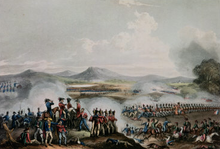
Back معركة طلبيرة (1809) Arabic Битка при Талавера Bulgarian Batalla de Talavera (1809) Catalan Bitva u Talavery Czech Schlacht bei Talavera (1809) German Μάχη της Ταλαβέρα Greek Batalla de Talavera (1809) Spanish Talaverako gudua Basque Bataille de Talavera French Bitka kod Talavere Croatian
This article includes a list of general references, but it lacks sufficient corresponding inline citations. (July 2011) |
| Battle of Talavera | |||||||
|---|---|---|---|---|---|---|---|
| Part of the Peninsular War | |||||||
 The Battle of Talavera de la Reina, by William Heath | |||||||
| |||||||
| Belligerents | |||||||
|
|
| ||||||
| Commanders and leaders | |||||||
|
|
| ||||||
| Strength | |||||||
|
46,138[1] 80 guns |
United Kingdom: 20,641[2] 30 guns Spain: 34,993[2] 30 guns Total: 55,634 60 guns | ||||||
| Casualties and losses | |||||||
| 7,389 killed, wounded or captured[3] |
United Kingdom: 6,268 killed, wounded or captured[3] Spain: 1,200 killed, captured or wounded[3] Total casualties: 7,468 killed, wounded or captured | ||||||

125miles
The Battle of Talavera (27–28 July 1809) was fought just outside the town of Talavera de la Reina, Spain some 120 kilometres (75 mi) southwest of Madrid, during the Peninsular War. At Talavera, a British army under Sir Arthur Wellesley combined with a Spanish army under General Cuesta fought in operations against French-occupied Madrid. At nightfall, the French army withdrew a short distance after several of its attacks had been repulsed; the allies, having suffered comparable casualties to the French, made no attempt to pursue.
After Marshal Soult's French army had retreated from Portugal, General Wellesley's 20,000 British troops advanced into Spain to join 33,000 Spanish troops under General Cuesta. They marched up the Tagus valley to Talavera, some 120 kilometres (75 mi) southwest of Madrid. There they encountered 46,000 French under Marshal Claude Victor and Major-General Horace Sébastiani, with the French king of Spain, Joseph Bonaparte in nominal command.
The French crossed the Alberche in the middle of the afternoon on 27 July. A few hours later, the French attacked the right of the Spaniards and the British left. A strategic hill was taken and lost, until, finally, the British held it firmly. At daybreak on 28 July, the French attacked the British left again to retake the hill and were repulsed when the 29th Foot and 48th Foot who had been lying behind the crest stood up and carried out a bayonet charge. A French cannonade lasted until noon, when a negotiated armistice of two hours began. That afternoon, a heavy exchange of cannon fire started ahead of various infantry and cavalry skirmishes. Early in the evening, a major engagement resulted in the French being held off. A cannon duel continued until dark. At daylight, the British and Spanish discovered that the bulk of the French force had retired, leaving their wounded and two brigades of artillery in the field. Wellesley was ennobled as Viscount Wellington of Talavera and of Wellington[4] for the action.